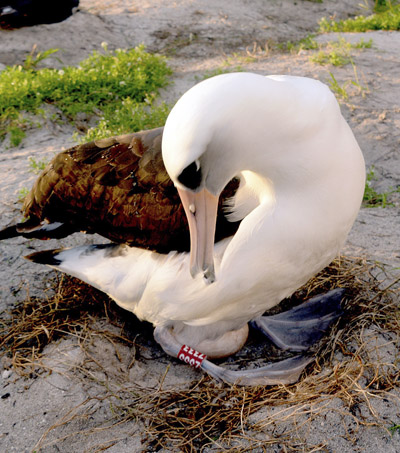Published in the Ocean Watch column, Honolulu Star-Advertiser © Susan Scott
January 12, 2015
Wisdom is in her 60s.
I couldn’t join the albatross-counting team on Midway this year, but my heart is there with the 14 volunteers and the million or so of my sweet feathered friends.
Because albatrosses evolved with no predators, the birds really do feel like friends. Repeat volunteer Raquel Dow emailed, “Midway is as wonderful as ever. This afternoon, while I was waiting for my team, I sat on the ground and a Laysan albatross came up and started nibbling at my glove and sleeve.”
I’ve had similar experiences. Once, while I stood taking pictures, an albatross untied my shoelaces. When I bent down to retie them, another albie pulled tissues from my gaping pocket.
 Courtesy Greg Joder
Courtesy Greg Joder
U.S. Fish and Wildlife Service
Some birds also feel like old friends because they come back to the same spot year after year. There’s the one nesting in the bike rack, the one next to the dining room steps, and so on.
And then there’s Wisdom. The U.S. Fish and Wildlife Service announced that Midway’s remarkable Laysan albatross, Wisdom, has laid yet another egg.
Midway biologists gave the bird this fitting name when they discovered that she had been banded at Midway in 1956 when about 5 years old. (Fledged albatross chicks remain offshore until they are sexually mature, about five years, and then return to their birthplace to find a mate.) That makes Wisdom at least 63, raising chicks most of those years.
Soon after biologists discovered this bird’s age, I parked myself near the barracks where Wisdom sat brooding her egg. I shot photo after photo, and when she finally stood up — no leg bands. I had been taking pictures of Wisdom’s most recent husband.
Albatrosses have strong pair bonds — until death do they part. But if one dies, the other finds a new partner and carries on raising offspring. Researchers believe Wisdom has survived several mates.
Albatrosses (and many other birds) practice social, but not sexual, monogamy. If all the males in an area are taken, female albatrosses sometimes pair up, soliciting sperm donations from neighbor males surely happy to oblige.
Each female lays a fertile egg, but because two adults can feed only one chick, the females push one egg from the nest and raise the other.
Before DNA testing revealed that female-female pairs existed, Midway residents swore that some albatrosses laid two eggs, when researchers insisted they lay only one. We now know the reason behind the apparent discrepancy.
We women might not want to be raising kids at 63, but we sure can envy Wisdom’s appearance. Our old friend doesn’t look a day over 5.